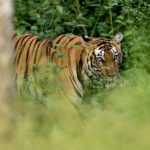Complete list of all Wildlife Sanctuaries of Karnataka, India
![[The WildTrails of India app is the best way to get all the details about Indian wildlife sanctuaries (best travel times, safari details, animal sightings, forest accommodations pairing, wildlife related activities, prices, etc). Learn more about WildTrails of India here.]](https://wildtrails.in/wp-content/uploads/2015/10/TigerANDcub.jpg)
In this article I will cover all of wildlife sanctuaries including national parks, wildlife reserves, bird sanctuaries, Tiger Reserves, Elephant Reserves of the State of Karnataka, India. Also covered are the highlights of the place, best season & time to visit, how to get there, safari / boating/ trekking details, list of animals/birds you can expect to see there , entry/camera fees, of course all of the accommodations nearby and lot more. (These highlights are covered in our App – WildTrails of India – iOS is available, android is on the way).
In the ensuing articles, I will be covering the other Southern sates of Kerala, Tamil Nadu, Andhra Pradesh, Telangana & Goa before I move onto Central, West, East, North and North Eastern Parts of India.
Karnataka
The tourism board has the tagline – ‘One state many worlds’. Yes, there is everything integrated in Karnataka. From low altitude oceans to high altitude mountains and heritage reserved sites, never to forget about the dense woods. It takes more than a lifetime to explore the entire state, because there are lots in the state.
The state is loved by all over the globe. You would get any sort of travel destinations in the state. Craving for beaches? the Konkan coast is calling you. Are you an adventurer? There are high altitude mountains like Kudremukh, Mullayanagiri, Kumara Parvata, Kodachadri and many more in the areas of the western ghats. Looking for heritage sites? There are amazing sculptures with age old history in Hampi, Belur, Halebidu, andPattadakal to name a few.
Introduction to sanctuaries
“Karnataka is one of the most glorious and important wildlife refuges on Earth” – states David Attenborough in the famous documentary ‘Wild Karnataka’. The state is known for one of the richest in terms of wildlife. No doubt, it is a home to a lot of popular wildlife sanctuaries. More than 20% of Karnataka comes under the forest cover with 38,270 square kilometres of forest area. The western part of Karnataka is included in the western ghats as a biodiversity spot. The state has over 20 famous wildlife sanctuaries for now. Nagarhole and Bandipur Wildlife reserves are a common destination for wildlife enthusiasts. Moreover, Bandipur is a part of Nilgiri biosphere reserve that was declared by UNESCO back in 1986. Nagarhole forest reserve is considered as a must watch for the wildlife enthusiasts.
Why should we Need To Protect Wildlife Sanctuaries
Wildlife is indeed part and parcel of the ecosystem. Their existence is as important as ours to maintain the balance in ecology. Unfortunately, a lot of species are now in the list of endangered categories. There is a strong need to protect them from getting extinct. Extinction would lead to disturbance in the food chain and hence creating imbalance in the ecosystem. Kudos to the forest department who stretch themselves to protect the forest reserves and the wildlife around them. The tourists who wish to visit these sanctuaries can explore the woods fearlessly.
Consequently, Wildlife exploration is now a popular hangover among the young crowd of the era and a serious task for professional photographers. However, it is ethical to stick towards the forest protocols and cooperate with the forest officials. It is a necessity to be a responsible traveler for the moment. This is the need of the hour. As an explorer, you need to understand that you are visiting their home and the fauna should be treated accordingly. There are a lot of endangered species in the woods and they deserve to be protected.
Complete list of all Wildlife Sanctuaries of Karnataka
Nagarhole National Park:
Nagarhole National Park, a perfect gateway for nature lovers is located at a distance of 95 km from Mysore and it is spread between Mysore (Kabini) and Kodagu districts. It includes Forest, little streams, attractive waterfalls and valleys. This park is located to the northwest of Bandipur National Park. Kabini dam divides this park from Bandipur National Park. The Nagarhole National park gets its name from the combination of two Kannada words. ‘Naga’ meaning snake, and ‘hole’ meaning stream. It was setup in 1955 and is one of the best-managed parks in India. In 1975 its area stretched to 643.39 sq. km. The sanctuary comprises three forest ranges namely, Nagarhole, Kallahalla & Thitimathi. The original forest was once an exclusive hunting place for the erstwhile Maharajas of Mysore. The climate is tropical; summer is hot and winter is enjoyable. Nagarhole National Park is mostly moist mixed deciduous forest in the Southern parts, Dry tropical forest towards east (Bandipur) and Sub mountain hill valley swamp forest. Fascinating Nagarhole National Park Packages
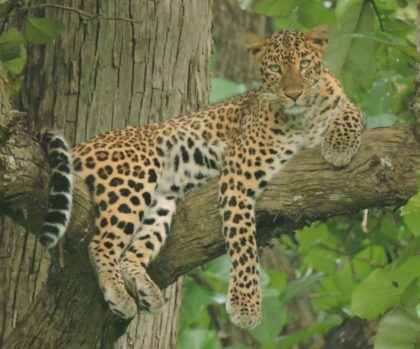
Bannerghatta National Park
Bannerghatta National Park is located at a distance of 22 km south of Bangalore. This 25,000 acre zoological park was established in 1971 and is one of the major tourist destinations of Bangalore. Ten reserve forests of Anekal Range of the Bangalore Forest Division come under this national park. One of the main attractions of Bannerghatta National Park is lion and tiger safari. The Tiger Reserve of the park has been recognized by the Forest Department of India. The other attractions of this park include its crocodile, snake farm and the Butterfly park.
To get the detailed info of the place, best season & time to visit, how to get there, safari details / boating/ trekking details, list of animals/birds you can expect to see there , entry/camera fees, and of course all of the accommodations nearby, please download the app or send us an inquiry:
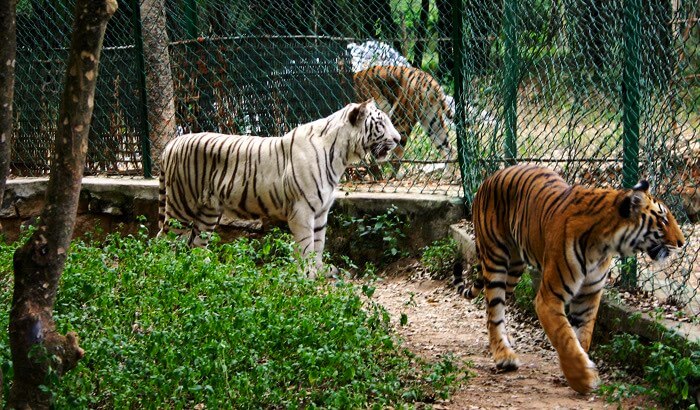
Anshi National Park
Anshi National Park is located at a distance of 60 km from Karwar in Uttara Kannada district. It is spread about 340 sq km and adjoins the Dandeli wildlife sanctuary. The forest in the area was declared the Dandeli wildlife sanctuary on 10 May 1956. A section of Dandeli wildlife sanctuary was carved out to form the Anshi National Park. Anshi National Park has been granted the status of Project Tiger sanctuaries in January 2007. It is located in an eco-sensitive part of the Western Ghats, at a height between 200 m to 925 m above sea level.
(Now Kali Tiger Reserve – Dec 2015)
![Anshi National park, [The WildTrails of India app is the best way to get all the details about Indian wildlife sanctuaries (best travel times, animal sightings, safari details, accommodations, activities, prices, etc). Learn more about WildTrails of India here.]](https://wildtrails.in/wp-content/uploads/2015/10/AnshiNationalPark.jpg)
Bandipur National park:
Bandipur National Park is located in Chamarajanagar district of Karnataka state, and is neighboring with the Mudumalai National Park of Tamil Nadu, the Wayanad Wildlife Sanctuary in Kerala, and the Nagarhole National Park to the northwest. it is about 80 km from Mysore city. The Maharaja of Mysore setup this park in 1931. The park is located at the foot of the Nilgiri Hills. It is between 680-1454 meters above sea level and is located south of the Kabini River in the foothills of the Western Ghats. It is one of India’s most famous sanctuaries, and is an important element of the project Tiger reserve. The Park houses about seventy tigers and over thousands of Asian elephants, as well as leopards, dholes, gaur and sloth bears. Bandipur is also a part of the Nilgiri Biosphere Reserve. Bandipur became one of the first of India’s Tiger Reserves in 1931. In 1974, the Bandipur was declared a National Park under the Wildlife Protection Act. Get Your Customised Bandipur Safari Packages
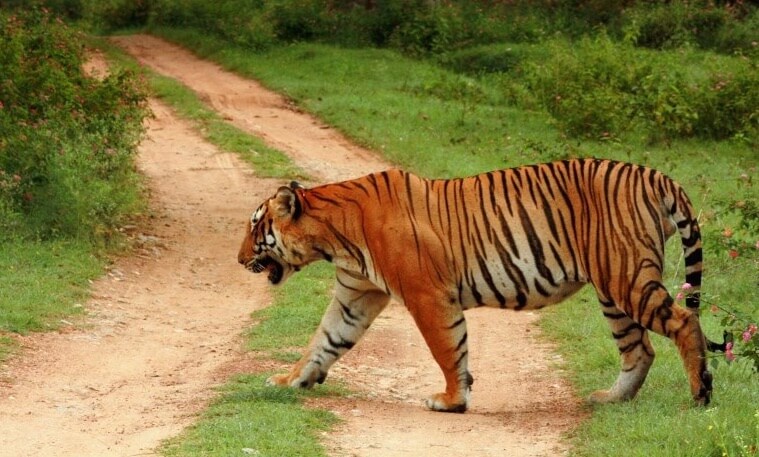
Kudremukh National Park
Kudremukh National Park is located at a distance of 95 km south-west of Chikmagalur town. It is situated in the Western Ghats in the districts of Dakshina Kannada, Udupi and Chikmagalur and stretches between Narasimha Parvatha (in Sringeri Taluk) in the north to the Jamalabad Fort (in Belthangady Taluk) in the south.It is popular for its scenic beauty, located in midst of mountains and is known for all kinds of flora and fauna spread over an area of 600.32 sq km and is 1,894.3 m above sea level. This Park was named after the eponymous peak, which is shaped like a horse face.It is divided into four ranges Kudremukh, Kerekatte, Kalasa, Shimoga. The park is covered with thick hilly forests, mostly evergreen and semi-evergreen near the coastal plains on the western portion. The park is surrounded by Coffee and Tea plantations on the northern and eastern boundaries. It receives an average annual rainfall of 7000 mm and the humid climate of the region and the tremendous water retention capacity of the shola grasslands and forests has resulted in the formation of thousands of perennial streams in the region converge to form three major rivers the Tunga, the Bhadra and the Nethravathi.
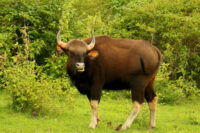
Arabithittu Wildlife Sanctuary
The Arabithittu Wildlife Sanctuary is situated in the Mysore district over an area of 13.5 sq. kms. One can find plantations of sandalwood and eucalyptus. As far as animals are concerned one can spot Leopard, fox, spotted deer, etc. The park boasts of more than 230 species of birds that have been observed over here in this park all these years. The Arabithittu State Forest is inside this wildlife sanctuary and is located in Mysore District at Hunsur Taluk of Karnataka State. This place also known as the Hunsur Territorial range. The chain link installed by the Defense Research Development Organization of Ministry of Defense is the boundary of the sanctuary. Also, the quarries located near to this sanctuary have been banned from operation.
![Arabithittu Wildlife Sanctuary, [The WildTrails of India app is the best way to get all the details about Indian wildlife sanctuaries (best travel times, animal sightings, safari details, accommodations, activities, prices, etc). Learn more about WildTrails of India here.]](https://wildtrails.in/wp-content/uploads/2015/10/ArabithittuWildlifeSanctuary2.jpg)
Bhadra Wildlife Sanctuary
Bhadra Wildlife Sanctuary situated in the midst of Western Ghats in Chikmagalur and Shimoga districts of Karnataka.The Bhadra Wildlife Sanctuary boasts of a substantial tiger population It was declared as the 25th Project Tiger of India in 1998. Kallahathigiri is the higest peak in the sanctuary with a height of 1,875 Mts. Kemmannugundi and Bababuden Hills, are within the sanctuary. The lush green vegetation and lofty hill ranges are a beautiful and spectacular. The wildlife sanctuary is called so after the Bhadra River which flows through the lush forests. The lush green vegetation of the Bhadra Wildlife Sanctuary consists of mostly moist and dry deciduous forests. More than 120 species of trees grow here, which include Teak, Rosewood, Mathi, Honne, Nandi, Tadasalu and Kindal. Bhadra is popularly known as Muthodi Wildlife Sanctuary, after the village on its fringes.
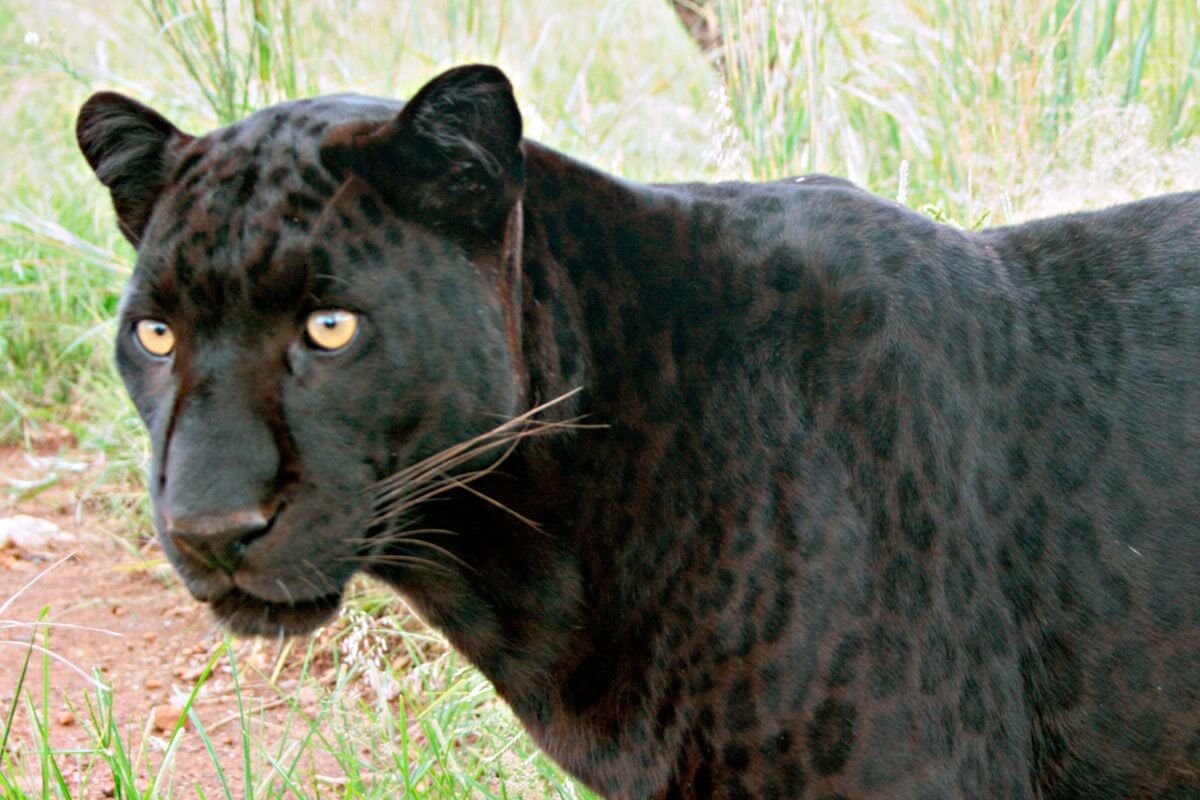
Bhimgad Wildlife Sanctuary
Bhimgad Wildlife Sanctuary is a protected area in the Western Ghats, in Khanapur Taluk of Belgaum District near Jamboti Village, Karnataka state, India. This 19,042.58 ha (73.5238 sq mi) of Tropical and subtropical moist broadleaf forests forest area was long awaiting to be a wild life sanctuary and finally declared in December 2011. The Bhimgad forests are notable for the Barapede caves, the only known breeding area of the Wroughton’s free-tailed bat, a threatened species on the verge of extinction. The sanctuary is also home to other rare species of flora and fauna. The area takes its name from the Bhimgad Fort which was built and commanded by Shivaji in the 17th century. It is located in the heart of the forest valley, Built by Shivaji to defend from the Portuguese troops who controlled Goa that time, rises 1800 ft near vertically above the plains. The fort occupied the summit of an extraordinary rock, with sides about 300 ft (91 m) in perpendicular height. The defenses were almost entirely natural, requiring little additional construction. The ruins of the 380-ft high and 825-ft broad Bhimgad fort are located right in the heart of the forest, and is of great historical significance.
![Bhimgad Wildlife Sanctuary [The WildTrails of India app is the best way to get all the details about Indian wildlife sanctuaries (best travel times, animal sightings, safari details, accommodations, activities, prices, etc). Learn more about WildTrails of India here.]](https://wildtrails.in/wp-content/uploads/2015/10/Bhimgad-Wildlife.jpg)
Biligiri Rangaswamy Temple (B.R.T.) Wildlife Sanctuary
The Biligirirangana Hills, commonly called B R Hills, is a hill range situated in south-eastern Karnataka, at its border with Tamil Nadu (Erode District) in South India. The area is called Biligiriranganatha Swamy Temple Wildlife Sanctuary or simply BRT Wildlife Sanctuary. It is a protected reserve under the Wildlife Protection Act of 1972. Being at the confluence of the Western Ghats and the Eastern Ghats, the sanctuary is home to eco-systems that are unique to both the mountain ranges. The site was declared a Tiger Reserve in January 2011 by the Karnataka government, a few months after approval from India’s National Tiger Conservation Authority. The hills are located at the easternmost edge of the Western Ghats and support diverse flora and fauna in view of the various habitat types supported. A wildlife sanctuary of 322.4 square kilometres (124.5 sq mi) was created around the temple on 27 June 1974, and enlarged to 539.52 square kilometres (208.31 sq mi) on 14 January 1987. The sanctuary derives its name Biligiri (Kannada for white rock) from the white rock face that constitutes the major hill crowned with the temple of Lord Rangaswamy or from the white mist and the silver clouds that cover these hills for a greater part of the year. The hills are in the Yelandur, Kollegal and Chamarajanagar talukas of Chamarajanagar District of Karnataka. They are contiguous with hills in Sathyamangalam Wildlife Sanctuary in Erode District of Tamil Nadu to the south. By road, they are about 90 kilometres (56 mi) from Mysore and 160 kilometres (99 mi) from Bangalore. The road leading to the village on top of the hills may be approached either from Yelandur or Chamarajanagar.
To get the detailed info of the place, best season & time to visit, how to get there, safari details / boating/ trekking details, list of animals/birds you can expect to see there , entry/camera fees, and of course all of the accommodations nearby, please download the app or send us an inquiry:
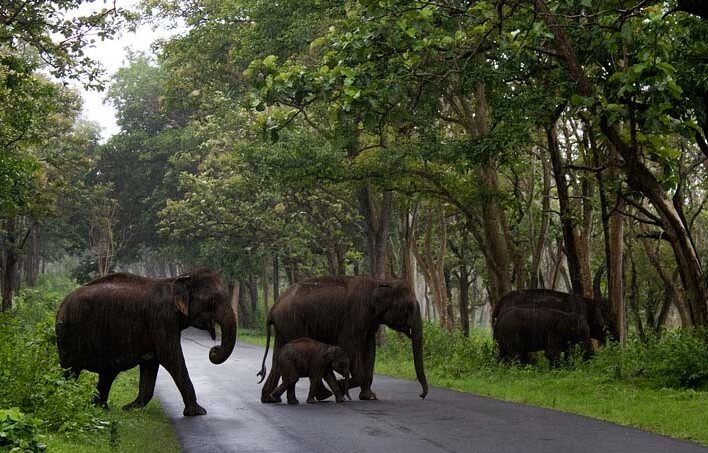
Brahmagiri Wildlife Sanctuary
The Brahmagiri wildlife sanctuary is located in the Kodagu (Coorg) district, Karnataka state and is part of the Western Ghats. It is situated on the border between Wyanad District of Kerala state on the south and Kodagu District in Karnataka on the north side. The sanctuary derives its name from the highest point, the Brahmagiri peak, which is 1607m in height. It covers an area of about 181 km.
The area has mainly evergreen and semi-evergreen forest, and in the higher altitudes, there are grasslands with shola forest patches. Bamboos are well represented in these forests. The top of Brahmagiri Hill is well forested and has a lot of wildlife.
![Brahmagiri Wildlife Sanctuary . [The WildTrails of India app is the best way to get all the details about Indian wildlife sanctuaries (best travel times, animal sightings, safari details, accommodations, activities, prices, etc). Learn more about WildTrails of India here.]](https://wildtrails.in/wp-content/uploads/2015/10/Brahmagiri-Wildlife-Sanctuary.jpg)
Cauvery Wildlife Sanctuary
Cauvery Wildlife Sanctuary is a protected area located in the Mandya, Chamarajanagar and Ramanagar districts of Karnataka. The Cauvery River passes through its midst. It was established in 1987.The Sanctuary spans an area of 1027.535 square kilometers. On its east, it adjoins Dharmapuri forest division of Tamil Nadu state. The Major portion of the forests are of South Indian dry deciduous type. It is home to mammals like elephant, wild boar, leopard, dhole, spotted deer, barking deer, four-horned antelope, chevrotain, common langur, bonnet macaque, honey badger (ratel), malabar giant squirrel, smooth-coated otter and Grizzled giant squirrel. The river cauvery also houses various species of reptiles like the Mugger crocodile,Indian mud turtles, and various species of snakes. This is also one of the few places to find mahseer fish. The central and eastern parts of the sanctuary are well forested, Hogenakal falls (Smoking rock in Kannada), Mekedatu (Goats leap), Sangam (The point where the Arkavathi river joins the Cauvery) and Muthathi (The religious place where lord Anjaneya temple is situated) are of cultural, historical and tourist interest. The eastern part of the sanctuary is completely bounded by the state of Tamilnadu. Four wildlife ranges have been created for this sanctuary i.e. Kanakapura, Hanur, Cowdally and MM Hills wildlife ranges. The following Reserve Forests are included in the Sanctuary Basavanabetta S.F, Chilandavadi S.F, Muggur S.F, Chikkayalur S.F & Mahadeswara R.F.
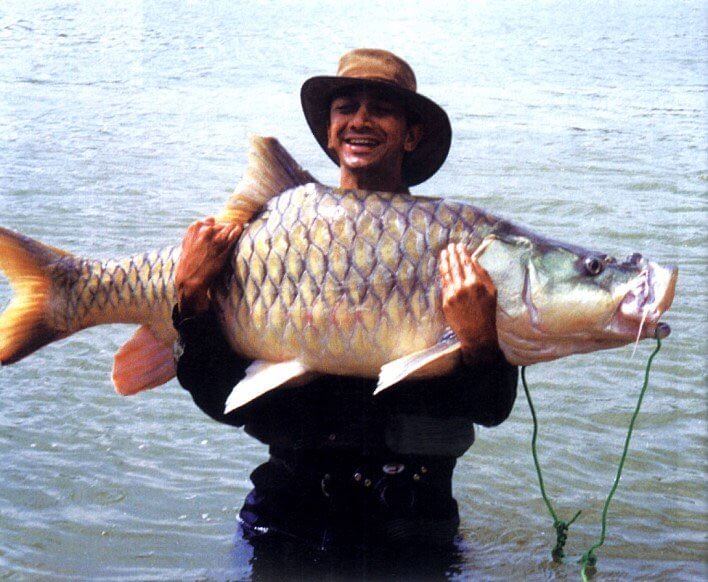
Dandeli Wildlife Sanctuary
Dandeli Wildlife Sanctuary is located in Uttara Kannada District of Karnataka state in India. The sanctuary covers an area of 866.41 km2 (334.52 sq mi). Along with neighboring Anshi National Park (339.87 square kilometres (83,980 acres)), the sanctuary was declared part of the Anshi Dandeli Tiger Reserve in 2006. Karnataka state government has officially notified the Dandeli Elephant Reserve under Project Elephant on 4 June 2015. The elephant reserve is spread over 2,321 sq km, including 475 sq km as core and the remaining as buffer areas. This is the second elephant reserve in Karnataka after Mysuru Elephant Reserve, which was declared in 2002. Dandeli Wildlife Sanctuary is a birdwatchers paradise, housing nearly 200 species of Birds, most famous for the Great Hornbill (Great Indian Hornbill or Great Pied Hornbill ) and the Malabar Pied Hornbill. It is also the only known Tiger Reserve in India to report frequent sightings of the elusive Black Panther. It is also know to house the Indian Sloth Bear, the Indian Pangolin, the Giant Malabar Squirell, Dhole, the Indian Jackal and the Muntjac (Barking Deer). Sightings of the Indian Elephant and the Indian Peafowl are pretty common. The King Cobra and the Maggur (Indian Crocodile) are the prime reptilians in Dandeli Wildlife Sanctuary. The forests in Dandeli are a mixture of dense deciduous trees interspersed with Bamboo and Teak plantations.
Daroji Bear Wildlife Sanctuary
Daroji Sloth Bear Sanctuary is located in Bellary district in Karnataka. It is spread over 55.87 square km. The sanctuary was exclusively created for the preservation of Indian Sloth bears. It is about 50 km from Bellary and near to World heritage site Hampi about 15 km. Government of Karnataka declared 5,587.30 hectares of Bilikallu reserve forest as a Daroji Bear Sanctuary in October 1994. The area between Daroji in Sandur taluk and Ramasagar of Hospet Taluk host to the Sloth Bears. The rock-strewn hillocks that stretch between Daroji of Sandur taluk and Ramasagar of Hospet Taluk in Bellary district have been the abode of Indian Sloth Bears since ages.
To get the detailed info of the place, best season & time to visit, how to get there, safari details / boating/ trekking details, list of animals/birds you can expect to see there , entry/camera fees, and of course all of the accommodations nearby, please download the app or send us an inquiry:
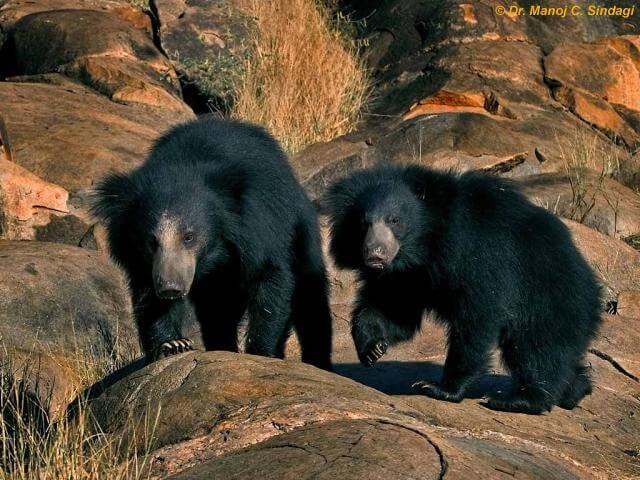
Jayamangali blackbuck reserve
Jayamangali (formerly Maidenahalli) Blackbuck Conservation Reserve is Tumkur district’s only notified protected area. It neighbours Maidenahalli, a small village in Madhugiri Taluk, at the north-eastern tip of Tumkur district of Karnataka state, India. This area is a part of the plains of Deccan plateau and borders Anantapur district of Andhra Pradesh. It is a 798-acre (3.23 km2) patch of grassland.It has the largest contiguous population of blackbuck in Karnataka, apart from Ranibennur Blackbuck Sanctuary.
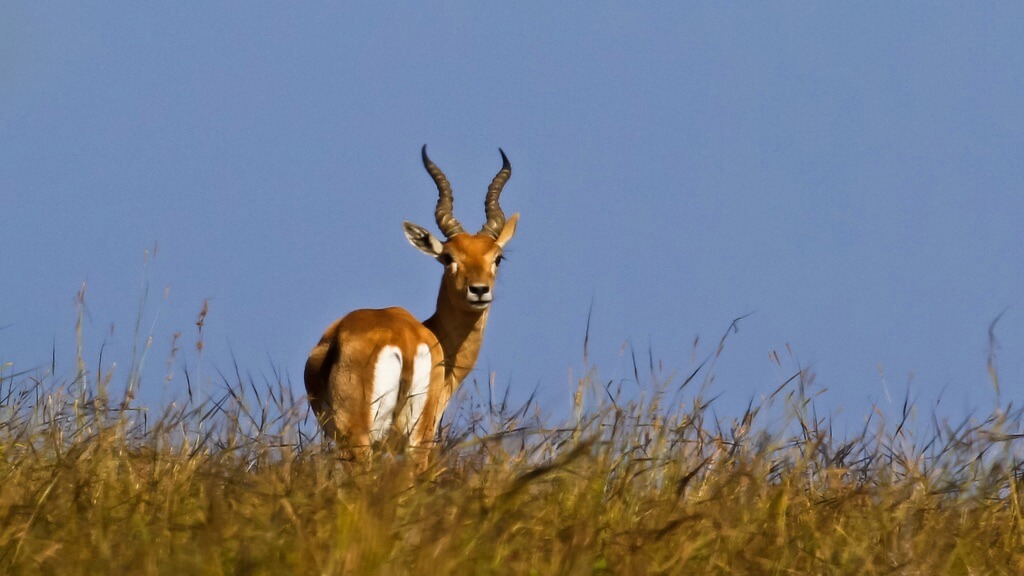
Melkote Temple Wildlife Sanctuary
Melkote Temple Wildlife Sanctuary (49.82 sq. km) is situated in Mandya district. This was declared as sanctuary on 17th June 1974 specifically to protect the habitat of Grey Wolf (Canis lupus pallipes). Sanctuary is named after the famous Melkote temples situated on the border of the sanctuary. The sanctuary comprises of two zones, Mudibetta (4.48 sq. km) and Narayandurga (45.34 sq. km). There are few villages between the two zones, and surrounding area is cultivated. The landscape is rocky, with Tropical dry deciduous and scrub vegetation.
![Melkote Wildlife Sanctuary, [The WildTrails of India app is the best way to get all the details about Indian wildlife sanctuaries (best travel times, animal sightings, safari details, accommodations, activities, prices, etc). Learn more about WildTrails of India here.]](https://wildtrails.in/wp-content/uploads/2015/10/melkote-wildlife.jpg)
Mookambika Wildlife Sanctuary
Mookambika Wildlife Sanctuary is located near Kollur in Udupi district. This sanctuary is spread around 247 sq. km. This sanctuary is sharing its north-western boundary with Sharavathi Wildlife Sanctuary. Mookambika wildlife sanctuary is located at a distance of 125 km from Mangalore. Mookambika wildlife sanctuary is divided into a core zone (114 sq. km), buffer zone (90 sq. km) and tourism zone (43 sq. Km). This sanctuary is thick with evergreen, semi-evergreen and moist deciduous forests of the Western Ghats. Some of the tree species found in this region includes Dipterocarpus indicus, Calophyllum tomentosum and Hopea parviflora.A rare species of climber Coscinium fenestratum are also found here. The endangered cane turtle is also found at this sanctuary.
![Mookabika Wildlife Sanctuary, [The WildTrails of India app is the best way to get all the details about Indian wildlife sanctuaries (best travel times, animal sightings, safari details, accommodations, activities, prices, etc). Learn more about WildTrails of India here.]](https://wildtrails.in/wp-content/uploads/2015/10/MookambikaWildlife.jpg)
Nugu Wildlife Sanctuary
Nugu Wildlife Sanctuary is situated in Heggadadevanakote Taluk of
Mysore district and comprises of Lakshmanapura State Forest and adjacent revenue lands this sanctuary is situated north of Bandipur National Park. This small sanctuary with an area of 30.32 Sq.Km. has not yet been opened for tourist. The backwaters of Nugu dam forms the part of the Nugu Wildlife Sanctuary and lies on the western side of the sanctuary.
To get the detailed info of the place, best season & time to visit, how to get there, safari details / boating/ trekking details, list of animals/birds you can expect to see there , entry/camera fees, and of course all of the accommodations nearby, please download the app or send us an inquiry:
![nugu wildlife sanctuary, [The WildTrails of India app is the best way to get all the details about Indian wildlife sanctuaries (best travel times, safari details, animal sightings, forest accommodations pairing, wildlife related activities, prices, etc). Learn more about WildTrails of India here.]](https://wildtrails.in/wp-content/uploads/2015/10/NuguWildlifeSantuary.jpg)
Pushpagiri Wildlife Sanctuary
Pushpagiri (92.65 sq. Kms) situated in the western Ghats, the area has a thick evergreen and semi-evergreen forests, and shola-grassland habitat in the higher areas. the steep terrain of the sanctuary has resulted in some impressive waterfalls along the various streams that originate in these mountains. It is located in the Kodagu district. Between November and March is the best time for wildlife viewing in the sanctuary.
Ranebennur BlackBuck Wildlife Sanctuary
Ranebennur (119 sq. kms) Sanctuary was declared as a Sanctuary mainly to protect Blackbuck. It comprises of two unconnected portions, an eastern and a western bit. The sanctuary has a core zone of 14.87 sq. Kms and a buffer-cum tourism zone of 104.13 sq. Kms. the area is covered mainly by scrub forest and Eucalyptus plantations, and is also inhabited by the highly endangered Great Indian bustard and the wolf. Agricultural fields surround the Sanctuary. It is located in the Haveri district. Between October and March is the best time for observing Blackbuck, while the bustard is most easily sighted from February to June.
![Ranebennur BlackBuck Wildlife Sanctuary [The WildTrails of India app is the best way to get all the details about Indian wildlife sanctuaries (best travel times, animal sightings, safari details, accommodations, activities, prices, etc). Learn more about WildTrails of India here.]](https://wildtrails.in/wp-content/uploads/2015/10/RanebennurBlackBuckWildlifeSanctuary.jpg)
Sharavathi Valley Wildlife Sanctuary
Sharavathi Valley Wildlife Sanctuary is spread over inthe Sharavathi River Valley of Sagar Taluk in Shimoga District. The area of the Sanctuary is 431.23 Sq. Kms out of which an area of 123.63 Sq. Kms is under the water spread of Sharavathi Reservoir. The Sanctuary lies in the Western Ghats, mainly covered with evergreen and semi-evergreen forests in the valleys and grassy patches on hill tops, and is immensely rich in flora and fauna both in variety and diversity. Parts of the sanctuary, mostly in the grassy blanks, have been planted up with Acacia auriculiformies, Cashew and fruit yielding species. They are immensely rich in species like Dhoopa, Gulmavu, Surahonne, Mavu, Nandi etc. They harbour wildlife like Bison, Spotted deer, Tiger, Panther etc. The hilly areas actually drain water to area than to the catchment Sharavathi River, clustered with small and big nalas. The area serves as living place for many vertebrates and invertebrates. The sanctuary has got innumerable herbs, shrubs, ferns and grasses many of which are yet to be surveyed and listed.
![Sharavati valley Wildlife Sanctuary, [The WildTrails of India app is the best way to get all the details about Indian wildlife sanctuaries (best travel times, safari details, animal sightings, forest accommodations pairing, wildlife related activities, prices, etc). Learn more about WildTrails of India here.]](https://wildtrails.in/wp-content/uploads/2015/10/Sharavati-Valley-Wildlife-Sanctuary.jpg)
Shettihalli Wildlife Sanctuary
Shettihalli Wildlife Sanctuary is located in Shimoga District and lies adjacent to Shimoga town. It was declared a wildlife sanctuary on Nov, 23 1974.It is spread about 395.6 sq. Km and it is divided into a core zone (100.6 sq. km), a buffer zone (237.4 sq. km) and a tourism zone (57.6 sq. km). It has mostly dry and moist deciduous forests in the eastern and central parts. Towards the west, with an increase in rainfall, there are semi-evergreen forests.
![Shettihalli wildlife sanctuary , [The WildTrails of India app is the best way to get all the details about Indian wildlife sanctuaries (best travel times, safari details, animal sightings, forest accommodations pairing, wildlife related activities, prices, etc). Learn more about WildTrails of India here.]](https://wildtrails.in/wp-content/uploads/2015/10/Shettihalli-wildlife-Sanctuary.jpg)
Someshwara Wildlife Sanctuary
Situated in the Western Ghats, the Someshwara Wildlife Sanctuary covers an area of 88.4 88.4 sq. km in Udupi District, Karnataka. It was declared a Wildlife Sanctuary in 1974, and abounds in wild critters typical to South-east Asia. The Someshwara Wildlife Sanctuary is divided into two parts, each separate from the other. The smaller section is situated towards the southwest of the larger section. The sanctuary is mostly made up of evergreen forests, semi evergreen and moist deciduous forests. It is situated very close to the much bigger Kudremukh National Park. However, that does not in any way take away from the beauty of the sanctuary or the amount of wild flora and fauna found here.
![Someshwara wildlife sanctuary, [The WildTrails of India app is the best way to get all the details about Indian wildlife sanctuaries (best travel times, safari details, animal sightings, forest accommodations pairing, wildlife related activities, prices, etc). Learn more about WildTrails of India here.]](https://wildtrails.in/wp-content/uploads/2015/10/Someshwara-Wildlife-Sanctuary.jpg)
Talakaveri Wildlife Sanctuary
Talakaveri Wildlife Sanctuary is located in Kodagu (Coorg) district and lies in the Western Ghats. This sanctuary is named after Talakaveri, the origin of the Cauvery River which lies on the eastern edge of the sanctuary. The origin of the river Cauvery is place of religious importance for the people of Kodagu.
Talakaveri was declared as Wildlife Sanctuary on 31 Aug / 1 Sep 1987. Talakaveri wildlife sanctuary is spread about 105.01 sq. km and it is covered with tropical evergreen forests. A few coffee and cardamom plantations are also covered within the sanctuary.
![Talakaveri Wildlife Sanctuary, [The WildTrails of India app is the best way to get all the details about Indian wildlife sanctuaries (best travel times, safari details, animal sightings, forest accommodations pairing, wildlife related activities, prices, etc). Learn more about WildTrails of India here.]](https://wildtrails.in/wp-content/uploads/2015/10/Talakaveri-Wildlife-Sanctuary.jpg)
Adichunchunagiri Bird Sanctuary
Perched at an altitude of 700- 1000 m above sea level, the Adichunchanagiri Sanctuary was established mainly to protect peacocks in its vicinity. Besides peacock, you can spot variety of butterflies, birds especially Yellow-throated Bulbul. Other habitats include fruit bats, mongoose, hare and bonnet macaque. It is worth paying a visit this sanctuary in Mandya district.
To get the detailed info of the place, best season & time to visit, how to get there, safari details / boating/ trekking details, list of animals/birds you can expect to see there , entry/camera fees, and of course all of the accommodations nearby, please download the app or send us an inquiry:
![Adichunchunagiri Bird Sanctuary, [The WildTrails of India app is the best way to get all the details about Indian wildlife sanctuaries (best travel times, safari details, animal sightings, forest accommodations pairing, wildlife related activities, prices, etc). Learn more about WildTrails of India here.]](https://wildtrails.in/wp-content/uploads/2015/10/Adichunchunagiri-Bird-Sanctuary.jpg)
Attiveri Bird Sanctuary
Attiveri Bird Sanctuary is a village in the Mundgod taluk of Uttara Kannada district in the Indian state of Karnataka. It lies 15 km from Mundgod and 43 km from Hubli-Dharwad. Spread over an area of about 2.23 km2, the sanctuary is located in and around the Attiveri reservoir. The part of the sanctuary surrounding the reservoir has riverine and deciduous forests.
![Attiveri Bird Sanctuary [The WildTrails of India app is the best way to get all the details about Indian wildlife sanctuaries (best travel times, safari details, animal sightings, forest accommodations pairing, wildlife related activities, prices, etc). Learn more about WildTrails of India here.]](https://wildtrails.in/wp-content/uploads/2015/10/Attiveri-Bird-Sancturay.jpg)
Bankapura Peacock Sanctuary
Karnataka has two peacock sanctuaries, one at Adichunchanagiri and an other at Bankapura fort. Bankapur Peacock sanctuary is in side the Bankapura Fort in Bankapura in Haveri District. The peacock sanctuary in Bankapur[2] is the only second sanctuary in the country that is exclusively engaged in the conservation and breeding of peacocks. Understanding the great presence of peacocks in the region, the Government of India declared Bankapura as a peacock sanctuary on June 9, 2006. Any visitor to this sanctuary will not return without seeing a flock of peacock, our national bird, happily dancing in the sprawling sanctuary, without a care in the world. This sanctuary is situated on 139 acres of land which has the remains of the historic Bankapura Fort. The high mound and deep trenches of the land have provided a perfect home for these birds. The sanctuary is located on the cattle breeding farm which was set up in 1919 after the First World War. The farm is located in 90 acres (360,000 m2), out of the total 139 acres (0.56 km2) of the sanctuary. According to a rough estimate, there are more than 1,000 peacocks and peahen in the sanctuary. Bankpura Fort is home for not only for peafowl, but also a number of other birds like wood pecker, great-horned owl, babbler, magpie, robin, green bee eater, nightjar, spotted maina, paradise flycatcher, Indian robin, spotted dove, parakeets, kingfisher, grey hornbill, blue tailed bee eater, blacked winged kite, tailor bird etc.
![Bankapura Peacock Sanctuary, [The WildTrails of India app is the best way to get all the details about Indian wildlife sanctuaries (best travel times, safari details, animal sightings, forest accommodations pairing, wildlife related activities, prices, etc). Learn more about WildTrails of India here.]](https://wildtrails.in/wp-content/uploads/2015/10/Bankapura-Peacock-Sanctuary.jpg)
Bonal Bird Sanctuary
Bonal Bird Sanctuary sometimes spelled as Bohnal Bird Sanctuary is bird sanctuary and wetland near Bonal village in the Shorapur taluk of Yadgir district in Karnataka state, India. It is the second largest bird sanctuary in the state, after Ranganthittu Bird Sanctuary in Mysore, and around 21 species of birds have been recorded here, including purple heron, white-necked stork, white ibis, black ibis, brahminy duck, and bar-headed goose. The sanctuary has its origins in the Bonal tank, a water conservation tank built by the 17th century ruler of Shorapur, Pam Naik, later during the British Raj, Meadows Taylor, the British administrator at Shorapur, extended it to 1,600 acres with 12 feet average depth, as he mentions in his autobiography, The Story of My Life. It was one of largest amongst the twelve such water tanks built in the drought prone region, and gradually started attracting migratory birds. Most of these tanks were using were also used for fishing, and numerous families were dependent on it. In 1998, heeding to calls by conservationists, the state government transferred the area to the Forest Department from the Fisheries Department. Subsequently fishing was banned the tank, but it took many more years before it was formally declared a bird sanctuary.
![Bonal Bird Sanctuary, [The WildTrails of India app is the best way to get all the details about Indian wildlife sanctuaries (best travel times, safari details, animal sightings, forest accommodations pairing, wildlife related activities, prices, etc). Learn more about WildTrails of India here.]](https://wildtrails.in/wp-content/uploads/2015/10/Bonal-Bird-Sanctuary.jpg)
Ghataprabha Bird Sanctuary
Ghataprabha Bird Sanctuary is located in Gokak taluk of Belgaum district in Karnataka. The Sanctuary is located in an area of 29.78 square kilometres, and its boundaries enclose a stretch of about 28 km of the Ghataprabha River. The sanctuary is known for its migratory birds such as the demoiselle crane, European white stork etc. The sanctuary is surrounded by agricultural fields and the best time to visit the place is between November and March, when most of the migratory bird species nest there.
![Ghataprabha Bird Sanctuary,[The WildTrails of India app is the best way to get all the details about Indian wildlife sanctuaries (best travel times, safari details, animal sightings, forest accommodations pairing, wildlife related activities, prices, etc). Learn more about WildTrails of India here.]](https://wildtrails.in/wp-content/uploads/2015/10/Ghataprabha-Bird-Sanctuary.jpg)
Gudavi Bird Sanctuary
Gudavi Bird Sanctuary is located in the Sorab taluk of Sagara Subdivision in the Indian state of Karnataka. Gudavi Bird Sanctuary is located on the Banavasi Road in Gudavi of Sorab Taluk which is 16 km from Sorab town. The bird sanctuary is one of the best five of Karnataka. It is spread over an area of 0.74 square km. As per survey, 217 different species of birds belonging to 48 families are found at this place. A natural lake and the trees gives shelter to this birds. The picturesque Gudavi Lake with trees all along its banks is a beautiful sight in itself. It is a small seasonal lake and is filled with water mostly in the rainy season. Various avian species migrate from across the globe in different seasons for breeding. A platform is built for bird watchers to have a closer look at the birds.
![Gudavi Bird Sanctuary, [The WildTrails of India app is the best way to get all the details about Indian wildlife sanctuaries (best travel times, safari details, animal sightings, forest accommodations pairing, wildlife related activities, prices, etc). Learn more about WildTrails of India here.]](https://wildtrails.in/wp-content/uploads/2015/10/Gudavi-Bird-Sanctuary.jpg)
Kaggaladu Heronry
The Kaggaladu Bird Sanctuary is the second largest painted storks sanctuary in South Asia, right after KokkareBellur. The place is a must visit for bird watchers, as the beautiful birds can be seen nesting in the region all through the peak season. The season starts in February and runs through till August. In August you can see the remaining few birds, or as the locals say, the lazy birds! Kaggaladu is a village in the Sira Taluk of Tumkur District. The storks are important to the villagers, here, and in order to preserve their natural habitat, tamrind trees are mainted for the birds to roost and nest on.
To get the detailed info of the place, best season & time to visit, how to get there, safari details / boating/ trekking details, list of animals/birds you can expect to see there , entry/camera fees, and of course all of the accommodations nearby, please download the app or send us an inquiry:
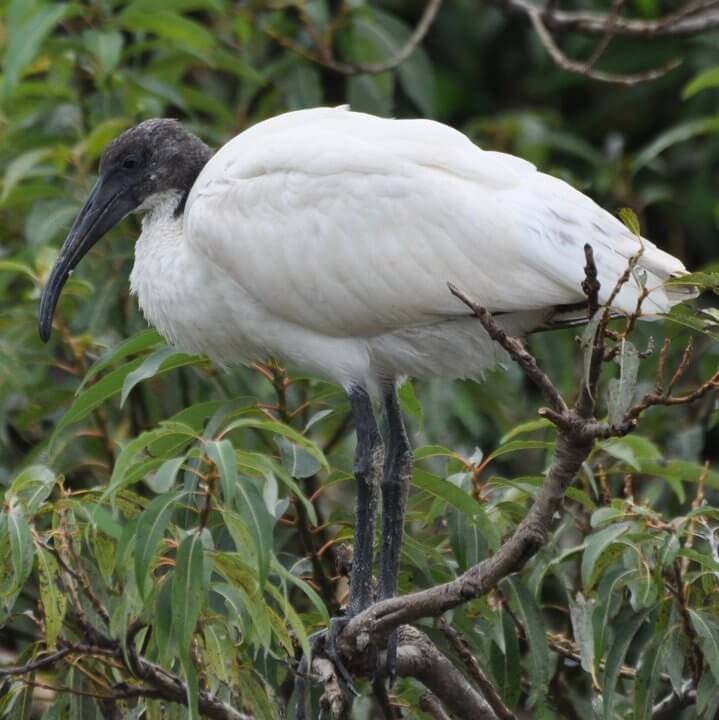
Kokkare Bellur Pelicanry
This place is famous for its Spot Billed Pelicans and the Painted Storks that can be sighted here in vast numbers during season time. This scenic village has paddy fields, cattle, water, and lots of exotic birds. The village is in the Maddur Taluka of the Mandya district of Karnataka. Kokkare is the local name for “Painted Storks” that are very famous in this region, “Bellur” meaning village of jaggery (raw sugar from sugarcane); hence, the village has derived its name from the bird. The village thrives on the bird’s droppings, which are called “guano”, as they are rich in potassium. The villagers use these bird droppings as manure for their cultivation. Indeed, the villagers believe that the birds bring in good luck and prosperity. That is the beauty of this place the birds love the habitat and the people love the birds! The district abounds in sugarcane fields and this village is famous for having large colonies of Spot-billed Pelicans and Painted Storks nesting in trees within the village.
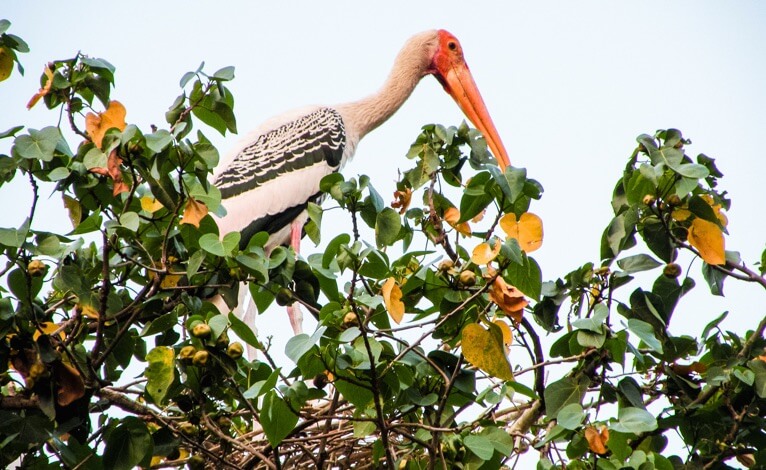
Magadi Bird Sanctuary
Magadi Bird Sanctuary created at the Magadi tank, it is one of the biodiversity hotspots of Karnataka. The Magadi tank is located in Magadi village of Shirhatti Taluk, Gadag District. (Please note that this is not the same magadi that is close to Bangalore) From Gadag it is 26 km, it is located on Gadag-Bangalore Road, from Shirhatti it is 8 km, and from Lakshmeshwar 11 km. The bar-headed goose[2][3] is one of the birds which migrate to Magadi wetlands. Normally birds eat fish, amphibians, molluscs, snakes etc., but migratory birds eating agricultural produce is both interesting and curious too. In the winter it feeds on barley, rice and wheat and may damage crops.
![Magadi Bird Sanctuary, [The WildTrails of India app is the best way to get all the details about Indian wildlife sanctuaries (best travel times, safari details, animal sightings, forest accommodations pairing, wildlife related activities, prices, etc). Learn more about WildTrails of India here.]](https://wildtrails.in/wp-content/uploads/2015/10/Magadi-Bird-Sanctuary.jpg)
Mandagadde Bird Sanctuary
Mandagadde Bird Sanctuary is located at a distance of 30 km from Shimoga on the way to Theerthahalli from Shimoga. Though Mandagadde Bird sanctuary is not considered one of the biggest of the bird sanctuaries of Karnataka, it is a habitat for a variety of birds. Mandagadde bird sanctuary is one of the few bird sanctuaries in the Malnad region which is spread about 1.14 acres and surrounded by dense forest. This picnic spot houses some of the spectacular migratory birds. A small island is formed by the flowing river Tunga, and the dense of trees on the island provide shelter for immigrating birds. The birds like Median Egret, Little Cormonant, darter or snake-bird etc., comes from different parts of the world during May for breeding. The breeding cycle will be completed by October and the migrated birds return home with their young ones.
![mandagadde bird sanctuary, [The WildTrails of India app is the best way to get all the details about Indian wildlife sanctuaries (best travel times, safari details, animal sightings, forest accommodations pairing, wildlife related activities, prices, etc). Learn more about WildTrails of India here.]](https://wildtrails.in/wp-content/uploads/2015/10/mandagadde-bird-sanctuary.jpg)
Ramanagar Vulture Sanctuary
Karnataka’s only vulture sanctuary is present near Ramnagar at Ramadevara pada and has up to 25 critically-endangered Long-billed vultures (Gyps indicus). The 346.41 hectares of hillock area, part of a reserve forest, was declared a sanctuary on January 30, 2012 and chain-link fencing was done. The hill gets its name from the temple dedicated to Lord Rama which is situated atop this hill. The hill Ramadevara pada, along with Savandurga was one of the shooting locations for David Lean’s A Passage to India. Small door like grottoes were made in the rock to resemble caves. It was also in this region that the path-breaking Hindi movie, Sholay, was shot.
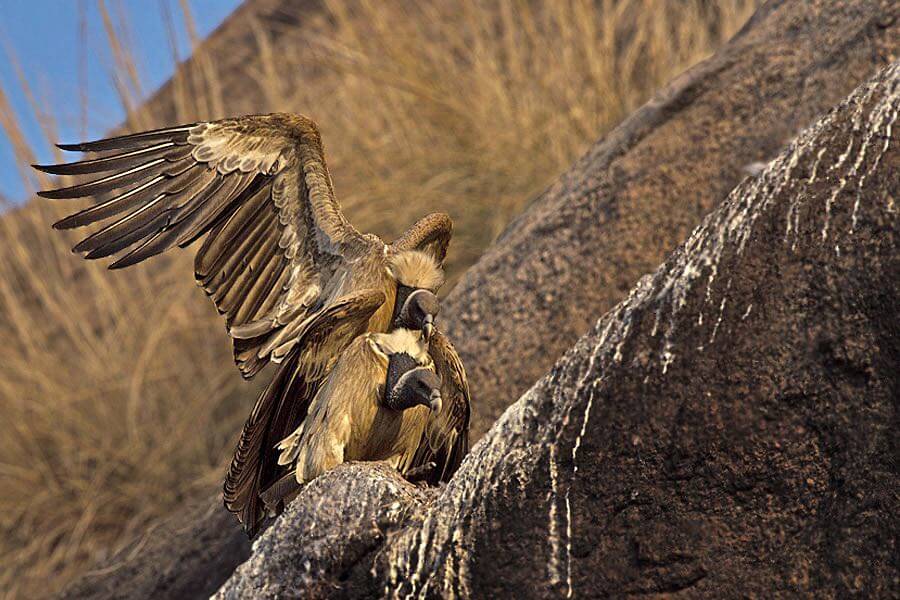
Ranganathittu Bird Sanctuary
The Ranganathittu Bird Sanctuary is situated at 4 Kms. from Srirangapatna and 19 Kms. from Mysore. The Bird Sanctuary is named after Sri Ranganatha Swamy, an incarnation of Hindu God Vishnu. It is an island on the river Cauvery and it is spread on an area of 40 acres. The Sanctuary includes six islands and was declared a bird sanctuary in 1940. This is an important nesting and breeding ground for the thousands of bird species. It witnesses the arrival of a large number of migratory birds of different flocks from as far as Siberia, North America and Australia. The migratory birds start arriving in December and the breeding season starts during the winter months and they finally migrate back with their nestlings in August. The islands host numerous mammals and migratory birds. Ranger-guided boat tours of the islands are available throughout the day, and are a good way to watch birds, crocodiles, otters and bats.
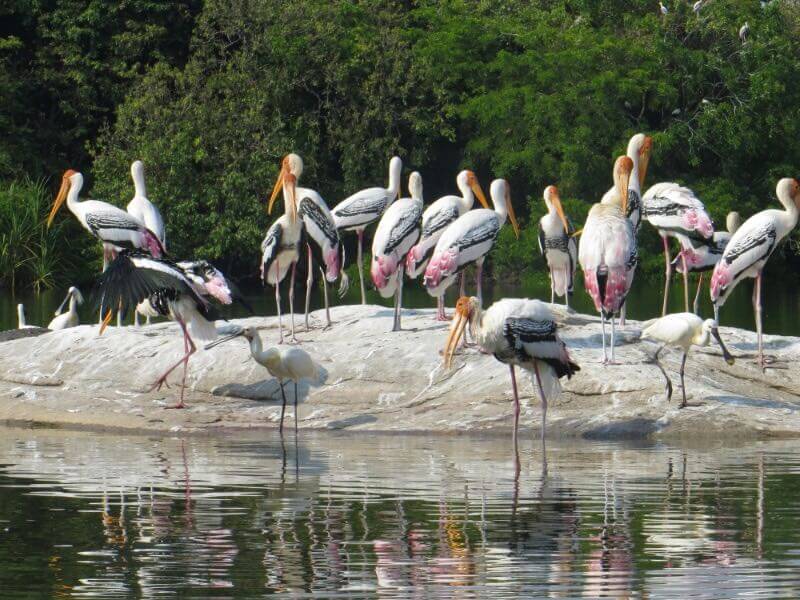
Do’s and don’t’s In National Parks:
Do’s
1. Groom up right for the adventure:
Wear light colored attire. Make sure that the limbs are covered. Avoid bright colors. Multi colored dress is recommended.
2. Less luggage more comfort:
Carry as light as possible. This holds good for any of the excursions. The expeditions can be tiresome and exhausting.
3. Stay calm:
Making unnecessary noises would only end up inviting trouble. Stay excited, but being calm and composed throughout the exploration.
4. Do not miss your camera:
A camera is a part of the exploration. You will come across wildlife sightings that are unexpected, breathtaking, and once in a lifetime moment. Capture them with a smile.
Carry your sunglasses, hats, and sunscreen to keep yourself safe from sun rays and sunburns. Wear strong jungle shoes along with socks. Avoid footwears which expose your feet to wild nature.
5. Always have an expert guide:
The naturalists are the crew who had been in and around the jungle for years. You need a high chance of sighting wildlife, it is always recommended to have them for your venture.
Don’t’s:
1. Don’t litter:
Ground rule – Do not carry non bio-degradable materials. The forest officials in any forests are strict of this and you may end up paying hefty funds just to ruin your holiday. Cleanliness is the key.
2. No feeding to animals:
This is like digging your own grave. The behaviour of wild animals are predictable to no one and hence feeding them would be risky.
3. Cellphones switched off throughout the drive:
You are on a vacation and no official/unofficial calls should spoil your vacation. Long press the power button of your device and keep it aside.
4. No loud conversations:
The excitement level will be at peak especially at the time of sighting. Just enjoy the moment with less or no talks.
5. No smoking or liquors:
Wildlife safari is a way to connect with the nature and any toxications are not at all entertained.
6. Do not over rely on properties for safari vacations:
There are a lot of licensed properties who can arrange for safari drives when you book with them. However, they do not promise. Pro-tip. Confirm your safari drives before booking the properties.
————————————–
With 4 years of Sightings data + Extensive expert tracker network in jungles, our customers had the best wildlife experiences.
Buy Wildlife Fashion Accessories
Exclusive Online Store for wildlife products
Packages
Packages Loading...
Recent Posts



![Pushpagiri Sanctuary Wildlife[The WildTrails of India app is the best way to get all the details about Indian wildlife sanctuaries (best travel times, safari details, animal sightings, forest accommodations pairing, wildlife related activities, prices, etc). Learn more about WildTrails of India here.]](https://wildtrails.in/wp-content/uploads/2015/10/Pushpagiri-Sanctuary.jpg)


